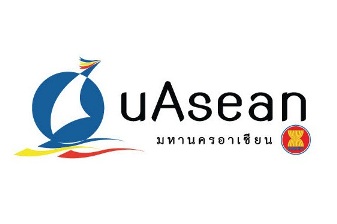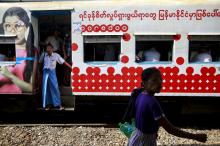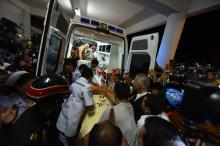President expects $5,000 per-capital income by 2003
Myanmar Eleven May 20, 2015 1:00 am
#block_media{
position:relative;
display:block;
clear:both;
}
#tab_photo,#tab_video{
display:inline-block;
width:60px;
height:auto;
padding:3px;
position:absolute;
top:-25px;
left:500px;
text-align:center;
background-color:#ccc;
color:#000;
cursor:pointer;
z-index:0;
}
@-moz-document url-prefix() {
#tab_photo,#tab_video{
top:-26px;
}
}
#tab_video{
left:564px;
}
#block_media .tab_media_active{
background-color:#0c3e6f;
color:#fff;
}
#slides_box,.box-vdo-top{
z-index:600;
}
Myanmar's per-capita income might reach US$5,000 by 2030, said President Thein Sein.
At the 2015 Presidential Awards Ceremony, the president hoped that the income would rise in line with the country's economic growth pace.
"If we observe forecasts made on current economic development and future possibilities, Myanmar's economic growth should remain at 7 to 8 per cent in the medium term," he said.
"In 2030, the growth rate might be 9.5 per cent. The per-capita income could then reach US$5,000," Thein Sein told the audience gathering at the Myanmar International Convention Centre.
He was referring to economic forecasts by the International Monetary Fund (IMF), World Bank, Asian Development Bank (ADB), the United Nations Economic and Social Commission for Asia and the Pacific and the Organisation for Economic Cooperation and Development.
According to the United Nations data, the country’s per-capita income in 2012 stood at $1,125.9. That showed an increase from $799.5 in 2010 and $237.8 in 2005.
ADB forecasts Myanmar economic growth at 8.3 per cent and 8.2 per cent in 2015 and 2016, respectively.
The IMF expected the real GDP growth to decelerate slightly to 7.8 per cent in the 2014-15 fiscal year, from 8.3 per cent in the previous fiscal year, due to slower growth in the agricultural sector.
"The growth outlook of the Myanmar economy remains favourable over the medium term, but downside risks for the near term have increased. Fiscal risks stem from spending pressures, including a potential large increase in public sector wages, which will raise inflation expectations. The external current account deficit could widen further, and shortfalls in foreign direct investments and other capital inflows could result in slower reserve accumulation," said Yongzheng Yang, chief of the IMF mission to Myanmar which completed the country visit in February.
President Thein Sein saw the need to further boost production and trade.
He said at the event here that to improve production and trade, increased investment in human resources was needed.
The increased business investment was needed at a regional and state level, he stressed.
53 Viewed
googletag.display('div-gpt-ad-1407393128989-0'); var switchTo5x=false; stLight.options({publisher:'6d3040a3-8e61-4630-98b5-3f5875b38d3e'}); Latest stories in this category


"In 2030, the growth rate might be 9.5 per cent. The per-capita income could then reach US$5,000," Thein Sein told the audience gathering at the Myanmar International Convention Centre.
He was referring to economic forecasts by the International Monetary Fund (IMF), World Bank, Asian Development Bank (ADB), the United Nations Economic and Social Commission for Asia and the Pacific and the Organisation for Economic Cooperation and Development.
According to the United Nations data, the country’s per-capita income in 2012 stood at $1,125.9. That showed an increase from $799.5 in 2010 and $237.8 in 2005.
ADB forecasts Myanmar economic growth at 8.3 per cent and 8.2 per cent in 2015 and 2016, respectively.
The IMF expected the real GDP growth to decelerate slightly to 7.8 per cent in the 2014-15 fiscal year, from 8.3 per cent in the previous fiscal year, due to slower growth in the agricultural sector.
"The growth outlook of the Myanmar economy remains favourable over the medium term, but downside risks for the near term have increased. Fiscal risks stem from spending pressures, including a potential large increase in public sector wages, which will raise inflation expectations. The external current account deficit could widen further, and shortfalls in foreign direct investments and other capital inflows could result in slower reserve accumulation," said Yongzheng Yang, chief of the IMF mission to Myanmar which completed the country visit in February.
President Thein Sein saw the need to further boost production and trade.
He said at the event here that to improve production and trade, increased investment in human resources was needed.
The increased business investment was needed at a regional and state level, he stressed.
53 Viewed
googletag.display('div-gpt-ad-1407393128989-0'); var switchTo5x=false; stLight.options({publisher:'6d3040a3-8e61-4630-98b5-3f5875b38d3e'}); Latest stories in this category
- Japanese call for Yangon train work
- The Yangon's circular train line is seriously..
- YCDC to build six new street-crossing bridges in..
- President expects $5,000 per-capital income by..

- Luang Phor Koon dies at age of 91
- LUANG PHOR KOON PARISUTTHO, one of the country's..
- Thailand on the 'back foot' internationally
- Thai-Japanese rail link to Chiang Mai follows..



เครดิตและบทความเรื่องอื่นๆของ nation ดูทั้งหมด
719
views
Credit : nation
News


